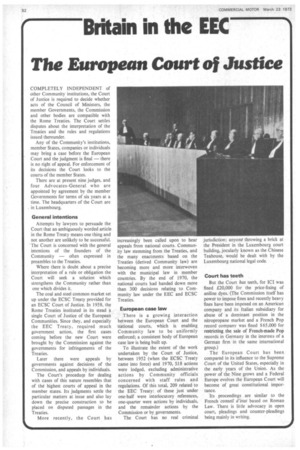( Britain in the EEC
Page 50

If you've noticed an error in this article please click here to report it so we can fix it.
The European Court of Justice
COMPLETELY INDEPENDENT of other Community institutions, the Court of Justice is required to decide whether acts of the Council of Ministers, the member Governments, the Commission and other bodies. are compatible with the Rome Treaties. The Court settles disputes about the interpretation of the Treaties and the rules and regulations issued thereunder.
Any of the Community's institutions, member States, companies or individuals may bring a case before the European Court and the judgment is final — there is no right of appeal. For enforcement of its decisions the Court looks to the courts of the member States.
There are at present nine judges, and four Advocates-General who are appointed by agreement by the member Governments for terms of six years at a time. The headquarters of the Court are in Luxembourg.
General intentions Attempts by lawyers to persuade the Court that an ambiguously worded article in the Rome Treaty means one thing and not another are unlikely to be successful. The Court is concerned with the general intentions of the founders of the Community — often expressed in preambles to the Treaties.
Where there is doubt about a precise interpretation of a rule or obligation the Court will seek a solution which strengthens the Community rather than one which divides it.
The coal and steel common market set up under the ECSC Treaty provided for an ECSC Court of Justice. In 1958, the Rome Treaties instituted in its stead a single Court of Justice of the European Communities. Since they, and especially the EEC Treaty, required much government action, the first cases coming before the new Court were brought by the Commission against the governments for infringements of the Treaties.
Later there were appeals by governments against decisions of the Commission, and appeals by individuals.
The Court's procedure for dealing with cases of this nature resembles that of the highest courts of appeal in the member states. Its judgments settle the particular matters at issue and also lay down the precise construction to be placed on disputed passages in the Treaties.
More recently, the Court has increasingly been called upon to hear appeals from national courts. Community law stemming from the Treaties, and the many enactments based on the Treaties (derived Community law) are becoming more and more interwoven with the municipal law in member countries. By the end of 1970, the national courts had handed down more than 300 decisions relating to Community law under the EEC and ECSC Treaties.
European case law There is a growing interaction between the European Court and the national courts, which is enabling Community law to be uniformly enforced; a consistent body of European case law is being built up.
To illustrate the extent of the work undertaken by the Court of Justice, between 1952 (when the ECSC Treaty came into force) and 1970, 5.18 actions were lodged, excluding administrative actions by Community officials concerned with staff rules and regulations. Of this total, 209 related to the EEC Treaty: of these just under one-half were interlocutory references, one-quarter were actions by individuals, and the remainder actions by the Commission or by governments.
The Court has no real criminal jurisdiction; anyone throwing a brick at the President in the Luxembourg court building, jocularly known as the Chinese Teahouse, would be dealt with by the Luxembourg national legal code.
Court has teeth
But the Court has teeth, for ICI was fined £20,000 for the price-fixing of aniline dyes. (The Commission itself has power to impose fines and recently heavy fines have been imposed on an American company and its Italian subsidiary for abuse of a dominant position in the nitropropane market and a French Pop record company was fined S65,000 for restricting the sale of French-made Pop records in Germany in the interests of a German firm in the same international group.)
The European Court has been compared in its influence to the Supreme Court of the United States, especially in the early years of the Union. As the power of the Nine grows and a Federal Europe evolves the European Court will become of great constitutional importance.
Its proceedings are similar to the French .conseil d'etat based on Roman Law. There is little advocacy in open court, pleadings and counter-pleadings being mainly in writing.












































































































